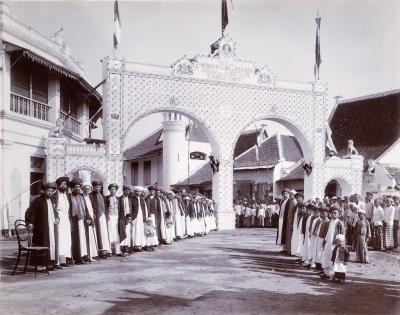On the legal status of colonial subjects
“Long Live her majesty Queen Wilhelmina of the Netherlands.” The text on this Triumphal Arch, put up by the Arab Community of Surabaya, East-Jawa, honored the young Queen Wilhelmina at her Coronation Day, 31 August 1898. Men and boy, apparently muslims, stand lined up, dressed in beautiful Arab or Javanese costumes, and ready to welcome the colonial authorities. The photograph comes almost at the end of a photograph exhibition (2011-2012) in the Tropenmuseum in Amsterdam, called “The Indies staged / Indië in scène –Photograph Studio Kurkdjian & Co (1888-1936)”
The exhibition has been the first ever devoted to the work of Ohannes Kurkdjian, a professional photographer of Armenian descent, who opened his photograph studio in Surabaya in 1888. His work would become well-known all around the world. Many people bought his photographs and kept them as souvenirs; they were printed in high print-runs, and many were used in school charts and other educational publications. Kurkdjian thus contributed to the creation of a widespread romantic image of the Netherlands-Indies. In references to “tempo doeloe”, the good old time, his photographs easily come to mind. The Tropenmuseum explained in the exhibition that this beautiful Indies-image was, however, carefully staged. One can see that people work hard, however, there is no sweat, tears and toll; people are beautifully dressed, healthy and exotic. “It seems”, the Tropenmuseum writes in the press release, “as if they benefit a lot from colonial rule.” With the exhibition, the museum aimed to deconstruct this beautiful Indies image, for instance by analyzing parallels in the composition with the romantic paintings of the nineteenth century. Through this critical art historical approach, the photographs would add to a better understanding of the impact of romanticism on colonialism’s culture in and outside of the colony.
Following this art historical approach, the Kurkdjian exhibition categorized the photographs by Kurkdjian in various genres: beautiful Indies pictures; natural disaster photographs (like a volcano eruption); corporate photography; commissioned portraits; and the series made in 1898 of the festivities in Surabaya during Queen Wilhelmina’s coronation day. The emphasis on the high aesthetic quality of the work of this professional photographer somehow was underlined with the information that two years before he died in 1903, Kurkdjian was issued a Royal Warrant. This happened after he had sent the photographs of Coronation Day as a gift to the Queen. She in turn, by allowing him to print the Dutch coat of arms on the cartons of his photographs, strengthened her visibility as well, as the Queen not only of the Netherlands, but overseas as well.
The exhibition does not discuss this, nor question, whether this honor implied a change in Kurkdjian’s civil status. Most of the men lining up in the photographs will have been either “Inlander” (natives) or “Foreign Orientals” (as was the legal status of colonial subjects of among others Arab, Armenian, Turkish or Chinese descent). Only the more privileged among them could obtain the legal status of “Equal to Europeans”. Few visitors today will be able to reflect on such a detail with respect to the life of this photographer, and the sensitivities of colonial subjecthood and citizenship. Certainly, most visitors will have recognized why Kurkdjian’s colonial everyday received royal approval.
Susan Legêne
